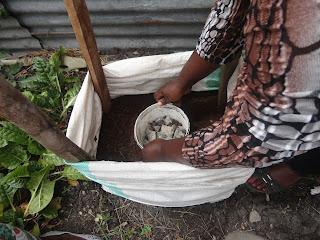A multi-storey garden is an upright sack filled with soil, in which food crops like vegetables, kales, carrots or onions grow in its sides.
This kind of farming is considered an urban farming method especially for people without enough farming land. Although many residents of Isinya have considerably large sizes of land, they are unable to practice year round crop production due to water scarcity. This is further made worse with the ever increasing food prices and unreliable rainfall. Multi-storey farming not only makes efficient use of water but it is also safe from droughts and floods. The way I see it, this kind of farming might actually hold the key to sustainable farming and food security in arid and semi arid areas like Isinya.
Women of Nassaru Ntoiye’s women’s group recently benefited from training on multi-storey farming. The training was facilitated by ALIN and conducted by Lois Gakuru an extension officer from the ministry of agriculture (MOA).
In order to make the sack garden, you need only a few requirements and to three hours of your time.
REQUIREMENTS FOR ONE 90 KG SACK/GUNIA
- 1 90kg gunia
- 2 wheelbarrows or 45 kgs of good soil
- 2 wheel barrows or 45 kgs of mature manure
- 1kg DAP (skip this if you are practicing organic farming)
- ¼ bag of small stones
- 4 wooden stakes
- Seedlings of kale or spinach
- A can or tin with no bottom or top
- Knife
- Enough water
TEN EASY STEPS
Step 1
Indentify and prepare site to place the garden making sure it is flat.
Thoroughly mix the soil, manure and the DAP
Step 2
Tear the bottom of the gunia such that it is open on both ends
Step3
Use the 4 stakes to ensure that the sack stands upright.
Step 4
Place the bottomless can in the middle of the sack and fill with stones
Step 5
Fill the area around the can with the soil, manure and dap mixture
Step 6
Pull the can up, refill it with stones and fill the area around with the soil mixture
Step 7
Water the soil mixture till it is well saturated (do this after every layer of soil mixture)
Step 8
Repeat steps 6 and 7 till the sack is full
Step 9
Make holes in the sack beginning from 1foot from the ground.
Insert a stick in each hole to form planting hole
The spacing between the holes across the sack should be one inch apart. You can use your hand to measure this, which is the distance between the tip of your middle finger and the tip of your thumb.
Step 10
Plant your seedlings in the planting holes on the side of the sack using a blunt stick
 | |
| NASSARU NTOIYE AND THEIR NEW SACK GARDEN |
QUESTIONS THAT CAME UP DURING THE TRAINING
WHY SMALL STONES?
The small stones in the middle of the sack not only enable for easy watering of your garden, but also enable aeration of the root area of the plant as well as providing a hold for the roots.
WOUNT THE PLANTS GROW FACING SIDEWAYS?
Remember that lower primary science and agriculture lesson where we learnt about phototropism???? That word ring any bells???? If it does then you know that the direction of a plants growth is determined by the direction of light source. As soon as the roots take hold the seedlings will stand upright towards the sun.
HOW OFTEN SHOULD THE GARDEN BE WATERED?
Preferably every evening. During the day a lot of evaporation takes place and plants therefore will not maximize water intake. You can also use the water you have rinsed your clothes in instead of pouring it.










